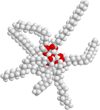A sucrose-derived scaffold for multimerization of bioactive peptides
- PMID: 21940174
- PMCID: PMC3197697
- DOI: 10.1016/j.bmc.2011.08.053
A sucrose-derived scaffold for multimerization of bioactive peptides
Abstract
A spherical molecular scaffold bearing eight terminal alkyne groups was synthesized in one step from sucrose. One or more copies of a tetrapeptide azide, either N(3)(CH(2))(5)(CO)-His-DPhe-Arg-Trp-NH(2) (MSH4) or N(3)(CH(2))(5)(CO)-Trp-Met-Asp-Phe-NH(2) (CCK4), were attached to the scaffold via the copper(I)-catalyzed azide-alkyne cycloaddition (CuAAC) reaction. Competitive binding assays using Eu-labeled probes based on the superpotent ligands Ser-Tyr-Ser-Nle-Glu-His-DPhe-Arg-Trp-Gly-Lys-Pro-Val-NH(2) (NDP-α-MSH) and Asp-Tyr-Met-Gly-Trp-Met-Asp-Phe-NH(2) (CCK8) were used to study the interactions of monovalent and multivalent MSH4 and CCK4 constructs with Hek293 cells engineered to overexpress MC4R and CCK2R. All of the monovalent and multivalent MSH4 constructs exhibited binding comparable to that of the parental ligand, suggesting that either the ligand spacing was inappropriate for multivalent binding, or MSH4 is too weak a binder for a second 'anchoring' binding event to occur before the monovalently-bound construct is released from the cell surface. In contrast with this behavior, monovalent CCK4 constructs were significantly less potent than the parental ligand, while multivalent CCK4 constructs were as or more potent than the parental ligand. These results are suggestive of multivalent binding, which may be due to increased residence times for monovalently bound CCK4 constructs on the cell surface relative to MSH4 constructs, the greater residence time being necessary for the establishment of multivalent binding.
Copyright © 2011 Elsevier Ltd. All rights reserved.
Figures










References
Publication types
MeSH terms
Substances
Grants and funding
LinkOut - more resources
Full Text Sources
Other Literature Sources
Chemical Information
Miscellaneous

